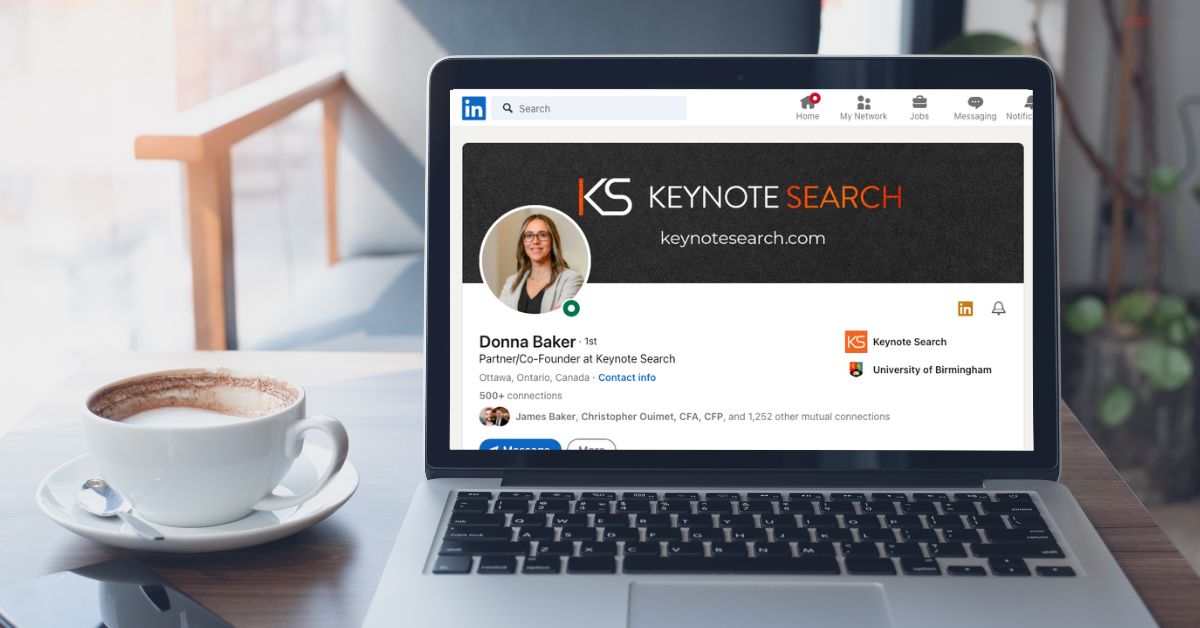Tips From Executive Recruiters to Maximize Your Executive Presence on LinkedIn
In the dynamic world of executive professionals, a robust LinkedIn presence is not just a luxury—it’s a necessity. LinkedIn has evolved beyond a mere job-search platform into a powerful networking and content-sharing hub for executives. Suppose you want to stand out to executive recruiters on LinkedIn who search and evaluate executive profiles daily. In that case, you need to optimize your entire presence on the platform beyond toggling the open-to-work option and inserting keywords on your profile.
“When I look at LinkedIn profiles, the first thing I look to understand is what you do, followed by who you do it for and your interests. If you look at your profile, does the story you tell when applying that logic truly reflect the maximum value you can bring to another employer?”
– James Baker, CEO, Keynote Search
We’ve compiled strategies to enhance your LinkedIn profile, establish a unique online persona, strategically grow your network, and curate compelling content that resonates with your audience and attracts executive recruiters to reach out. As a bonus, we even asked our executive recruiters to chime in with what they want to see from LinkedIn executives.
Crafting a Powerful LinkedIn Profile:
1. Optimize Your Headline:
Your headline is the first thing people see. Instead of a generic job title, you can craft a headline that succinctly conveys your expertise and value proposition. For example, instead of “Director of Executive Search at Keynote Search,” use something like Stephanie Aloia’s “Connector, Collaborator, Strategic Talent Partner” to show added value.
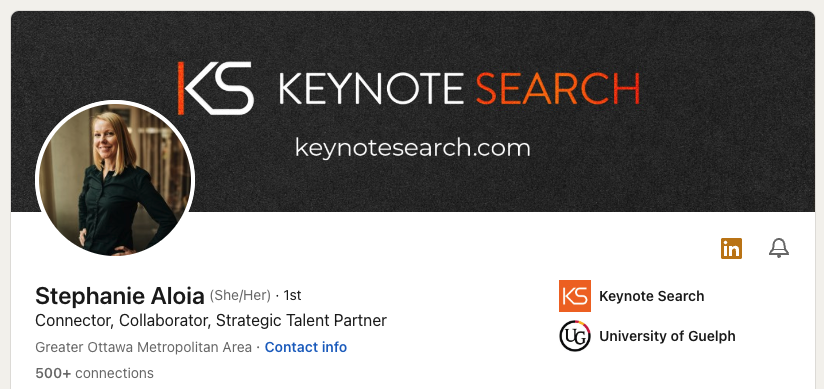
“Use your headline to convey your value proposition, skills, or what you’re passionate about. It’s your opportunity to make a strong first impression and stand out from the crowd.”
– Stephanie Aloia, Director, Executive Search – Keynote Search
2. Create a Compelling Summary:
Tell your professional story in the summary section. Highlight key achievements, skills, and your unique approach. Use a conversational tone to make your profile more approachable.
“Crafting a compelling summary is essential to ensure readers understand your core technical skills without any ambiguity when reviewing your experience. It also provides a platform to speak about who you are as a leader and the organizational culture you promote. Incorporate keywords relevant to your expertise and include a brief value proposition.”
– Stephanie Williams, Associate, Executive Search – Keynote Search
3. Showcase Accomplishments with Multimedia:
You can use the featured media section to showcase presentations, articles, or videos highlighting your achievements or uniqueness. This provides a more comprehensive view of your professional journey.
Check out our Virtual Chief Marketing Officer Kyle Turk’s profile for a sample where he highlights his community involvement and achievements.
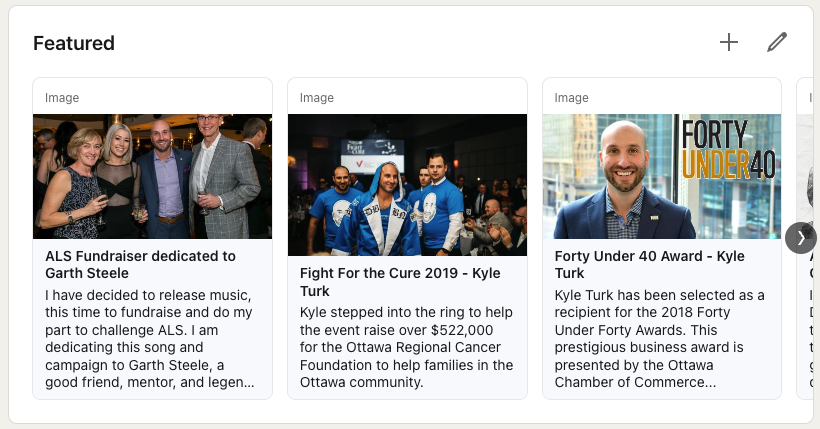
4. Get Personal with Your Experience:
Instead of just listing job responsibilities, share your impact in each role. Quantify achievements and use storytelling to make your experiences memorable.
“Keep your experience up to date by adding your latest achievements. Don’t just list tasks or copy and paste your job description.”
– Donna Baker, Partner, Executive Search – Keynote Search.
“If possible, provide links to relevant projects, case studies, or articles demonstrating your achievements. Directly linking to your work adds credibility.”
– Brenda Kirkwood, VP of Post-Placement Integration – Keynote Search.
5. Leverage LinkedIn Recommendations:
Request and provide thoughtful recommendations. These testimonials add credibility and provide insights into your leadership style and accomplishments.
“Think of recommendations as Google Reviews for you as an executive leader and professional. It’s an added reference layer for executive recruiters when presenting you for a new role to a potential employer.”
– Brad Ezard, COO – Keynote Search
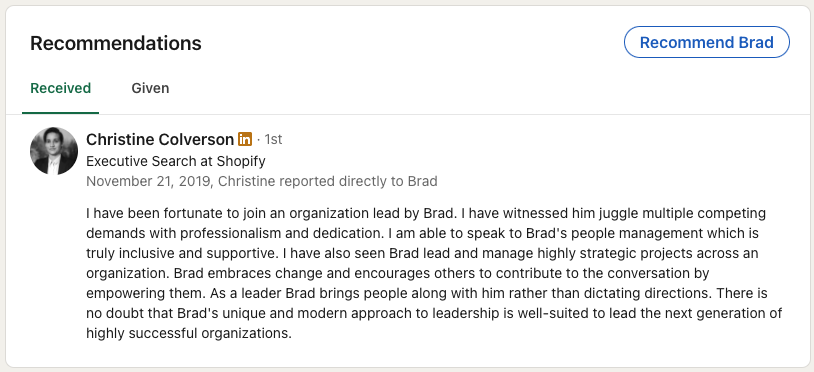
Building a Unique Executive LinkedIn Persona:
1. Professional Branding on LinkedIn:
Maintain consistency in your visual branding, including a professional headshot and a visually appealing banner. This creates a cohesive and memorable brand image. Check out Brock Murray, Co-Founder of seoplus+, for an excellent example of professional branding on LinkedIn.
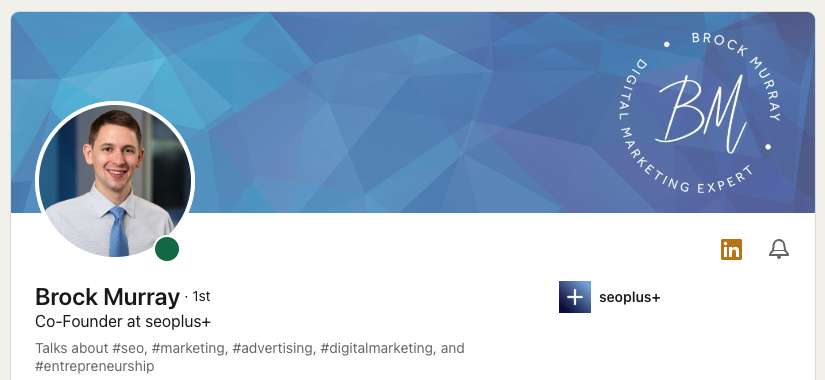
2. Use a Custom LinkedIn URL:
You can personalize your LinkedIn URL to make it easy to share and remember. This small detail can contribute to a polished and professional online presence.
3. Engage in Thought Leadership:
Share your insights on industry trends, challenges, and solutions. Write articles or posts that showcase your expertise and position you as a thought leader. Here’s an example from our CEO, James Baker.

4. Participate in Relevant Groups:
Join and engage in industry-specific LinkedIn groups. This expands your network and positions you as an active participant in your professional community.
Compelling LinkedIn Content Strategy:
1. Share Valuable Insights:
Regularly share content that adds value to your network. This could include industry news, your perspectives on current events, or tips relevant to your field.
“Keep your profile fresh by adding newsworthy content on trending topics. Your LinkedIn profile is a dynamic tool, not just an online resume.”
– Brenda Kirkwood, VP of Post-Placement Integration – Keynote Search

2. Tell Personalized Stories or Announcements:
Humanize your brand by sharing personal anecdotes related to your professional journey. This creates a deeper connection with your audience.
“LinkedIn is a great platform to establish your personal brand to showcase your skills and professional achievements. For example, if you’ve recently joined a Board of Directors, attended an impactful training conference, or are featured in an article, share it!”
– Kelsey Mayo, Manager, Executive Search – Keynote Search
3. Utilize Visual Content on LinkedIn:
Incorporate images, infographics, and videos into your posts. Visual content tends to receive higher engagement and is more likely to be shared. When executive recruiters review your profile and posts, they will stand out as more engaging and creative.
“Use impactful visuals: Incorporate multimedia elements, such as images, videos, or infographics, to tell your success stories. Visuals can grab attention and enhance engagement.”
– Brenda Kirkwood, VP of Post-Placement Integration – Keynote Search
Elevating your executive presence on LinkedIn is a multifaceted process that involves optimizing your profile, cultivating a unique online persona, strategic networking, and a compelling content strategy. By implementing these tips, you’ll enhance your professional image and unlock new opportunities and collaborations within the LinkedIn ecosystem. Remember, LinkedIn is not just a platform for job seekers—it’s a dynamic space for executives to connect, share, and lead in their respective industries.
Final Thought on Executive LinkedIn Profiles From Our CEO
“I’m looking to understand your expertise as quickly as possible, and often, you can get lost in a profile when there is a lack of clarity. Your LinkedIn profile should speak to the 4-5 things you are good at. Nothing is worse than a profile indicating you can do almost everything. I want to speak to someone who is either an expert or passionate about a specific topic, area or discipline. Don’t try to generalize; it is better to be everything to someone rather than failing at being something to everyone.”
– James Baker, CEO – Keynote Search
